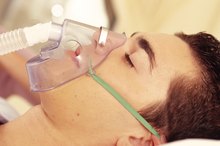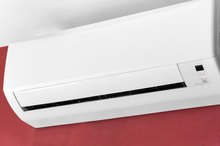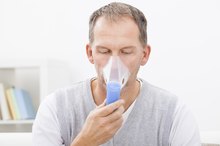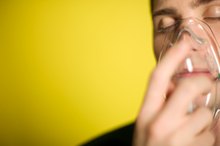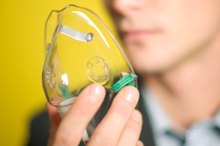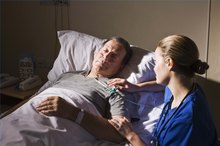How to Clean a BiPAP Machine
A BiPAP or bi-level positive airway pressure device, delivers two different pressures of air for the treatment of sleep apnea. A higher pressure of air is delivered when you inhale, and a lower pressure is used as you exhale. Routine maintenance of your machine is important, to not only extend the life of your device, but to keep dust and debris from accumulating within your BiPAP.
If you are experiencing serious medical symptoms, seek emergency treatment immediately.
Wash your BiPAP nasal mask or nasal pillows with a mild detergent soap and warm water in your sink daily. According to CPAPnow.com, agitate your gear in the water for up to five minutes.
How to Adjust the Airflow on a ResMed CPAP S6
Learn More
Rinse your gear thoroughly. Lay your nasal mask out on a towel to air dry.
Wash your BiPAP tubing twice a month, as indicated by the Lutheran Medical Center. The hose connects from the BiPAP device to your face mask. Wash your tubing in the sink by placing soapy water in the tube and rinsing the tube out. Place the tubing over your shower rod to dry.
Humidifier Mold Prevention
Learn More
Wash your headgear (straps) in soap and water when it becomes soiled with dirt. Lay out the headgear on a towel.
Wet a cloth and wipe your BiPAP machine when necessary. Wash filters in your machine that are non-disposable. Run the filter under tap water and air dry.
Wash your humidifier chamber in soap and water weekly. Disinfect your humidifier chamber with one part vinegar and up to five parts water, as stated by CPAPnow.com. The humidifier chamber should be disinfected to prevent the buildup of bacteria.
Tips
Cleaning your head gear in the morning will have your gear dry by night time.
Dust around your BiPAP to keep dust from settling on your device.
Replace disposable filters once a month and non-disposable filters once a year.
Warnings
Never use bleach to clean or soak the parts of your BiPAP. This can damage your equipment.
Never submerge your BiPAP machine in water.
Related Articles
References
- Panchabhai TS, Mireles cabodevila E, Pioro EP, Wang X, Han X, Aboussouan LS. Pattern of lung function decline in patients with amyotrophic lateral sclerosis: implications for timing of noninvasive ventilation. ERJ Open Res. 2019;5(3).doi.10.1183/23120541.00044-2019
- Hukins C, Murphy M, Edwards T. Dose-response characteristics of noninvasive ventilation in acute respiratory failure. ERJ Open Res. 2020;6(1).doi.10.1183/23120541.00041-2019
- Koga Y, Kaneda K, Fujii N, et al. Comparison of high-flow nasal cannula oxygen therapy and non-invasive ventilation as first-line therapy in respiratory failure: a multicenter retrospective study. Acute Med Surg. 2020;7(1):e461.doi.10.1002/ams2.461
- Donovan LM, Boeder S, Malhotra A, Patel SR. New developments in the use of positive airway pressure for obstructive sleep apnea. J Thorac Dis. 2015;7(8):1323–1342. doi:10.3978/j.issn.2072-1439.2015.07.30
- Ankjærgaard, K.L., Tønnesen, P., Laursen, L.C. et al. Home Non Invasive Ventilation (NIV) treatment for COPD patients with a history of NIV-treated exacerbation; a randomized, controlled, multi-center study. BMC Pulm Med 16, 32 (2016) doi:10.1186/s12890-016-0184-6
- COPD Working Group. Noninvasive positive pressure ventilation for chronic respiratory failure patients with stable chronic obstructive pulmonary disease (COPD): an evidence-based analysis. Ont Health Technol Assess Ser. 2012;12(9):1–51. PMID: 23074437
- Ankaergaard K, Tonnesen P, Laursen L, et al. Home NonInvasive Ventilation (NIV) treatment for COPD patients with a history of NIV-treated exacerbation; a randomized, controlled, multi-center study. BMC Pulmonary Medicine. 2016. 16(1):32.
- Johns Hopkins Medicine. Treatments and Tests: BiPap.
Tips
- Cleaning your head gear in the morning will have your gear dry by night time.
- Dust around your BiPAP to keep dust from settling on your device.
- Replace disposable filters once a month and non-disposable filters once a year.
Warnings
- Never use bleach to clean or soak the parts of your BiPAP. This can damage your equipment.
- Never submerge your BiPAP machine in water.
